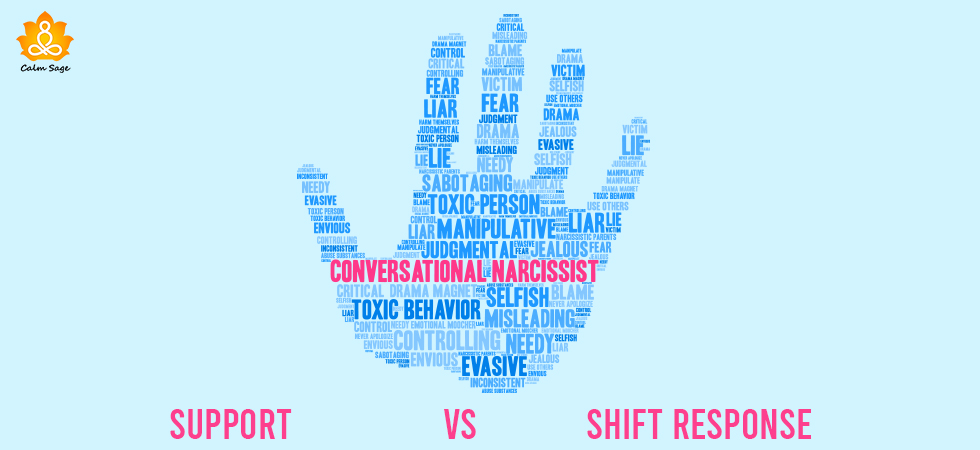Shift vs Support Response | HowTo Stop Being A Conversational Narcissist

This weekend I was watching a summary of the book “The Pursuit of Attention” written by sociologist Charles Derber. The part of the book that gained much attention from the world and intrigued me as well as the concept of Conversational Narcissist.
Trust me or not we all are guilty of being conversational narcissists at some point in our lives (wait till you agree with me on this one). That is the reason why we must understand why and how conversational narcissism creeps in our conversations with others, making us a shifter instead of a supporter.
What is Conversational Narcissism
In simple words, conversational narcissism is turning the direction of conversation towards self. It is that feeling when we can not wait for the other person to stop talking so that we can jump in. Conversational narcissism often subtly takes form wherein we might pretend we are listening but in the back of our head, we are just preparing our answers or statements to throw further in the conversation.
Why Should Conversational Narcissist Concern Me
Conversational narcissism is not just a hiccup in the way you communicate with people. It does impact other areas of your life as well.
- Conversational narcissism deteriorates your emotional intelligence.
- Being a conversational narcissist pushes you away from being an empathetic person.
- Conversational narcissism holds you back from being an active listener.
- It does not allow you to build communication and relationships with others.
These reasons make the practice of conversational narcissism concerning! To get better at conversation, listening, and relationship building.
Understanding Shift vs Support Response With Example
Shift Response: The Kind of Responses to Avoid
While giving a shift response to an individual we divert the conversation to ourselves (often unintentionally). We shift to topics that center around us and provide information for the same. These responses are a hallmark of conversational narcissism.
Example of Shift Response
Mr. X: I can’t sleep these days.
Mr. Y: Oh I have not been sleeping well for months now.
More about shift response
Shift responses open the opportunity for an individual to talk about their things and grab the attention of a person.
They are not a mark of being self-centered. Instead, it is our human tendency to open our memory files and look for similar experiences to connect with the other person. But, turning it 180 degrees towards you is where the problem is marked.
Also Read: 10 Bold Signs Of Dating A Narcissist
Support Response: The Kind of Response to Practice
Unlike shift response, support response allows you to make an effort to focus your attention on what the other person has to say, allowing you to seek information and understand the other person better. Here you encourage an individual to tell their story. The phrases you use here show that you are interested in their conversation and listening to the same.
Example of Support Response
Mr. X: I am unable to sleep these days.
Mr. Y: What happened? Is something bothering you?
Also Read: 7 Ways To Cope With Narcissists During Holiday Season
How to Switch from Shift to Support Response
There is no step-by-step guide to switching from shift to support response but there are some points for you to take care of.
1. Neutralize the shift response to support response. Sometimes sharing your life experience with the other person is good. But to make sure that you do not shift the communication completely to yourself, direct it back to the person.
Example:
Mr. X: I feel very down these days.
Mr. Y: I used to feel the same a few years back. What are you doing about it these days?
2. Back your responses with phrases. You can make your responses supportive by adding any of these three kinds of phrases:
- Background acknowledgment: Seriously? Tell me more! Uh-huh.
- Supportive assertion: You really thought that through! That is incredible. That is interesting!
- Supportive question: What do you like about it? Where did it all begin from?
Also Read: 5 Ways To Be Empathetic
3. Don’t interrupt competitively. Avoid interrupting a conversation from a competitive point of view. If someone interrupts while you are talking, ask them politely to let you finish first.
So which response are you going to practice from now? Shift response that marks a conversational narcissist or support response that makes you an empathetic being in the life of others.
Just notice your response next time, check if it is bouncing back to the person or staying in your basket. If it bounces back! Perfect! If not, then it is time to switch from shift to support response. Let us empathize, communicate, and connect.




















